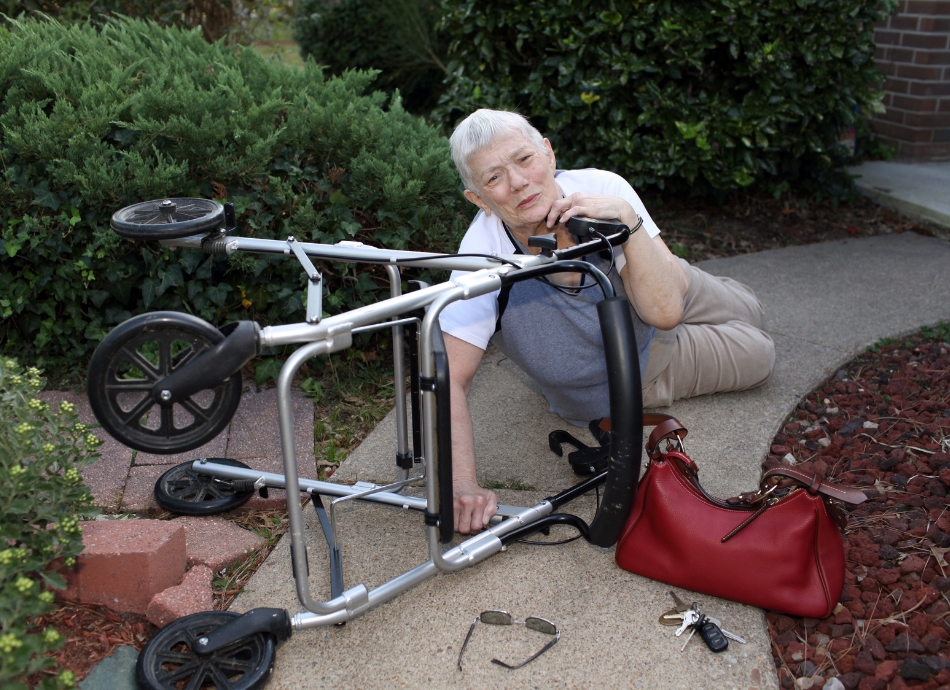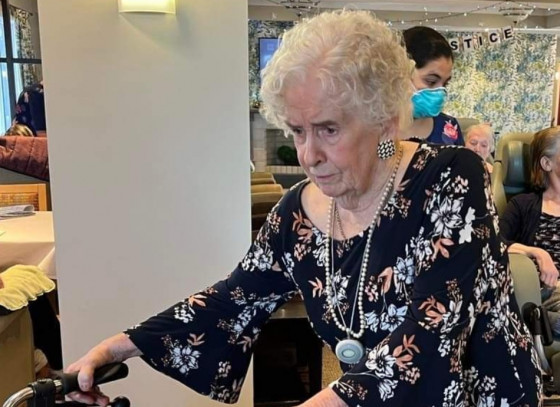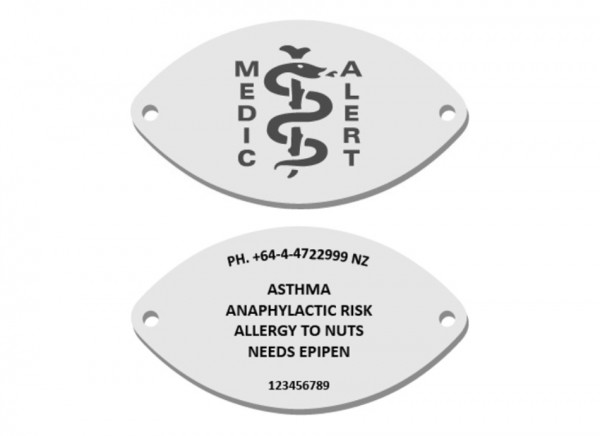Wishing everyone a safe and happy Christmas and New Year – Meri Kirihimete from the Healthify team.
Personal medical alarms and IDs
So you can get help when you need it
Key points about personal medical alarms and IDs
- If there are times you can't get to the phone or need medical help, a personal medical alarm or ID service can help.
- Personal medical alarms are a wearable alarm button kept on a necklace or on your wrist.
- Medical IDs are an identification bracelet or tag you wear, with information on it that other people can see and access.
- You might need one of these services if you're living on your own, getting older, have an illness or disability, or if you're worried about a whānau member.

When you need general medical advice you can call your healthcare provider or ring Healthline on 0800 611 116.
If it's a true emergency you can call Aotearoa New Zealand’s emergency number 111 and ask for an ambulance.
However, there may be times when you can’t get to the phone or may not be able to communicate information and this is where a personal medical alarm or medical ID service can help.
Your need for one of these services may be because you're getting older and feel less secure on your feet, or you or your whānau are concerned that you might have a serious health event eg, a heart attack or a stroke. Or perhaps you have a disability, or a health condition that affects your balance or mobility, or a serious allergy.
In the case of a medical ID, it may be useful if you have any medical condition, allergy, implanted device or need for medicine that could put you at risk of an emergency. They can also be used for people with dementia or Alzheimer’s, mainly as a form of identification.
Personal medical alarms are devices that plug into your landline or cellular network and wirelessly communicate with an alarm button kept on a chain around your neck (pendant), or on a wristband.

Image credit: Healthify He Puna Waiora
When you need help you press the button which sends a signal to the supplier’s call centre. When they receive a message from you they ring and you can tell them what you need. Some have a microphone to talk into. If you don’t, or are unable to, answer the phone an ambulance is automatically sent out to check on you.
The in-home medical alarm systems have a range similar to a cordless phone meaning that you can be covered around and close to your house. The anywhere medical alarms use the cellular network and are designed to take out with you as you go about your daily activities.
Costs vary depending on the supplier. The 4 MSD accredited suppliers (see below) provide:
- A single in-home alarm for $15.82 to $18.67 a week, with an additional cost of between $0 and $13.31 per week for an extra alarm at the same address.
- A single anywhere alarm for $17.04 to $29.99 a week, with an additional cost of between $12.10 and $19.99 per week for an extra alarm at the same address.
You can apply for funding through the Ministry of Social Development (MSD) if you have an ongoing illness or disability, of have had an injury. Whether or not you are eligible for funding will depend on your personal circumstances, eg, your income.
- If you have a health condition or disability you might be able to get support through a Disability Allowance from Work and Income.
- If you’ve had an accident or injury you may be able to get funding through the Accident Compensation Corporation (ACC).
- If you’re living in a retirement village the cost of an alarm might be built into the standard service fee you’re paying. If not, you can apply for a Disability Allowance to pay for it – if you are eligible.
If you’re not eligible for funding support through MSD, there are other options if you are a veteran or if you are 65 years of age or older.
- As a veteran you might be eligible for financial help for the cost of a medical alarm through the Veterans’ Independence Programme. Read more on the Veterans’ Affairs website.(external link)
If you're at least 65 years of age your SuperGold Card(external link) offers discounts from medical alarm supplies in some parts of Aotearoa New Zealand.
Everyone wanting to apply for funding for a medical alarm has to do the these things:
- Get your registered medical or nurse practitioner to fill out a disability allowance medical alarm assessment form(external link) for you.
- Get a copy of your service contract or a receipt for the installation and rental of the medical alarm.
This also applies if you currently have an in-home alarm and want to have one that works outside your home.
If you’re not currently getting a Disability Allowance you will also need to apply for one using this form(external link).
Read more about applying for funding for a medical alarm(external link).
There are 4 medical alarm suppliers currently accredited by MSD:
- ADT Security Ltd(external link) Phone: 0800 111 238.
- VitalCall (Chubb New Zealand)(external link) Phone: 0800 10 20 30.
- Freedom Medical Alarms (WFA)(external link) Phone: 0800 380 280.
- St John Medical Alarms(external link) Phone: 0800 502 323.
You can find out more about each of these suppliers, what they offer and what costs are involved by clicking on the links above or calling them.
The following video shows what happens behind the scenes when you press our St John medical alarm button.
Video: St John Medical Alarm 2018
(St John, NZ, 2018)
Note that these services all require you to take action at the time of an emergency. Another option is to wear an engraved medical identification so that others can act for you when you can’t.
Medical IDs provide a different type of service by enabling vital information about you (eg, an allergy, or diagnosis such as diabetes) to be engraved on a form of identification you wear all the time in case of an emergency situation where you can’t communicate for yourself. It helps you to prepare for the worst situation, where no-one around you knows who you are and what your health needs might be. For a one-off fee, My Identity(external link) provides identity bracelets, necklaces or tags engraved with your name, NHI number, condition and/or allergy and an emergency contact number.
Otherwise, you could just buy an identification bracelet or tag and get the information you want people to see engraved on it (including contact information on behalf of somebody with dementia who may have wandered from home and become disorientated).
However, if you want more support from a system that can access your important health information and get the help you need quickly, you might want to consider MedicAlert Services(external link).
The MedicAlert system(external link) protects your personal information by linking a membership number to an information service.
If you're unable to communicate for yourself, perhaps because you have lost consciousness, people around you can find out what your major health conditions/needs are and how to get help on your behalf from your MedicAlert ID.
All health information linked to your membership number is checked and validated by a clinician – this enables emergency responders to act quickly and with confidence.
There are certain rules about engraving that the Foundation follows:
- Personally identifying information is not engraved. Doing so may expose you to identity theft, harm your privacy, or attract the interest of unwanted attention, by people who may not have your best interests at heart. This can be particularly dangerous for vulnerable people, including children, older people, or adults dependant on a legal guardian.
- A genuine MedicAlert Medical ID, will always have the iconic MedicAlert logo, on the front of the ID (see below). This lets emergency first responders know they can trust and get access to your vital identification and emergency information.
- On the back of every MedicAlert Medical ID is a 24-hour emergency hotline number, including Aotearoa New Zealand’s country access code, so it’s accessible from overseas. There’s also an ID number, which can act as a Digital Access Key for use by authorised emergency first responders to securely and electronically, access your emergency information.
- In case of a natural disaster or civil deference emergency (when power lines, phone services and/or digital services may fail) your most serious, typically life-threatening, medical risks are engraved on your ID.
Here’s an example of what a MedicAlert ID looks like.

Image credit: MedicAlert NZ
The information kept in your MedicAlert digital health record includes:
- your National Health Index (NHI) number
- identity information
- emergency contacts
- the healthcare provider you’re enrolled with
- clinically validated health information.
The MedicAlert Foundation has a portal where you can add any additional information and documents you want responders to have access to. Your healthcare provider can also access your records to keep them up-to-date. If you need help in talking to your healthcare provider to make sure this is done, MedicAlert can assist you.
The only supplier accredited by MSD is MedicAlert(external link) and, as above with medical alarm services, you will need the assistance of your healthcare provider to apply for funding through a Disability Allowance.
Note: only the ongoing cost of membership service fees is funded by the Disability Allowance for people who qualify. If you can't pay for the initial enrolment fee or a bracelet/pendant, MSD may still be able to help if this is an immediate and essential need.
Read more about applying for funding for a MedicAlert® Medical ID.(external link)
There are 2 different plans available – the ‘Medical and Accident Service’ and the ‘Advanced Protection Service’.
As a charity, the Foundation supplies its services at charitable rates, with reduced fees for children and people with a Veterans or Seniors Gold Card.
Young families, who may not qualify for disability allowance funding, who face payment problems, can also request special consideration for a reduced fee. People with time-limiting terminal medical problems (eg, terminal cancer, with less than 1 year of life remaining), may also have fees waived on request.
Please view the schedule of fees(external link) for information about the different plans and what they cost. All pricing is subject to change and the Foundation’s Standard Terms of Service(external link).
Contact MedicAlert(external link) for more information.
Supporting the independence of older adults(external link), St John NZ English(external link), Samoan(external link), Filipino(external link), Mandarin(external link), Spanish(external link)
Videos
Freedom Medical Alarms – how it works(external link)
Freedom Medical Alarms – customer benefits(external link) also available in te reo Māori(external link), Samoan(external link), Mandarin(external link)
References
- Personal medical alarms(external link) New Zealand Government
- Medical alarm funding(external link) St John, NZ
- Medical alarms(external link) Work and Income, NZ
- MedicAlert Foundation(external link) NZ
Medical alarms(external link) Work and Income, NZ
Medical alarm scenarios for reference(external link) Work and Income, NZ. Provides scenarios for medical practitioners to use as a guide when deciding if a patient needs a medical alarm.
Credits: Healthify editorial team. Healthify is brought to you by Health Navigator Charitable Trust.
Reviewed by: Healthify editorial team.
Last reviewed:





